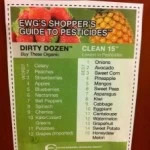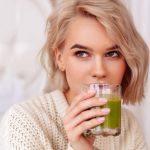By Sarah Finnie Robinson, Director of Social Programming at Practically Green
Sometimes it’s just one tiny little thing that makes my day: a single mincing step forward. Today I decided to post the dirty dozen list on my fridge.
This may not seem like such a big deal. It’s not something I learned in school, and you probably didn’t either — but the dirty dozen is very important. Potentially carcinogenic. It’s those 12 fruits and vegetables that absorb pesticide chemicals best. It’s what you should buy “organic” even though they may cost a little more. Because when you eat or serve the food on the dirty dozen list, you are unwittingly putting dangerous chemicals into you, and into your family and friends. Who would ever want to do that?
The truth is, I already knew about the dirty dozen — I have known about this for months! — but I was keeping this important information to myself. I suspect this is how it works in many households: Most of the time, the mom is the prep chef; grocery shopping and rinsing produce falls to yours truly. Let’s think: If I’m the VP in charge of Food, why don’t I share essential food info with my husband and my kids? Instead of lecturing them, why don’t I put it where I know they’ll read it: ON THE FRIDGE.
So today I went onto the Practically Green site, searched for to the Actions, searched for “dirty dozen” and found three. Here’s the first one:
Review the “dirty dozen” list of fruits and vegetables
Please, do your own clicking and research — but this is what I was looking for. Having read this action on Practically Green, I now know more about those dirty pesticides – i.e., I want them nowhere in my body — and I know more on what to do about it. At a minimum, I need to print out the list and post it on our fridge. Now I know where to go to get that done.
 There it is, on my fridge! Food you should buy organic on the left, and food that doesn’t matter as much on the right.
There it is, on my fridge! Food you should buy organic on the left, and food that doesn’t matter as much on the right.
What happens when you can’t find organic versions of the items on that Dirty Dozen list? Either skip them or wash them. Which brings us to another question they didn’t answer at my school: Wash them in what?
Luckily today’s New York Times offered a discussion of fruit-and-veggy-washing techniques. Conclusion: “To remove pesticides and germs, rinse produce with a vinegar solution, then wash with tap water for at least 30 seconds.”
I’m happy to follow this advice, but with one common-sense caveat: please be sure that your tap water is reasonably pure. After all, who wants to eat lettuce that’s been rinsed of pesticides, only to be spritzed with H2o carrying traces of chemicals and other people’s prescriptions?
 Is all this extra research and effort worth the trouble? Everyone will have to answer this for herself and her family, but for me it’s a no-brainer: Yes! Yes, it’s worth taking an extra step or two and spending an extra buck or two to serve delicious nutritious celery, peaches, strawberries, apples, blueberries, spinach, kale, potatoes, and all the rest. Of course it is! And posting the list is a terrific first step.
Is all this extra research and effort worth the trouble? Everyone will have to answer this for herself and her family, but for me it’s a no-brainer: Yes! Yes, it’s worth taking an extra step or two and spending an extra buck or two to serve delicious nutritious celery, peaches, strawberries, apples, blueberries, spinach, kale, potatoes, and all the rest. Of course it is! And posting the list is a terrific first step.
Click here for the Dirty Dozen phone app.
Author note:

Sarah Finnie Robinson is the Social Media director at Practically Green, a new website that coaches people on making eco-friendly and healthy everyday decisions.
Follow Practically Green on Facebook and Twitter for more on living a green life!




